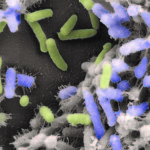Link to Pubmed [PMID] – 34818105
Link to DOI – 10.1128/AEM.01705-21
Appl Environ Microbiol 2022 02; 88(3): e0170521
Flavobacterium columnare causes columnaris disease in wild and cultured freshwater fish and is a major problem for sustainable aquaculture worldwide. The F. columnare type IX secretion system (T9SS) secretes many proteins and is required for virulence. The T9SS component GldN is required for secretion and gliding motility over surfaces. Genetic manipulation of F. columnare is inefficient, which has impeded identification of secreted proteins that are critical for virulence. Here, we identified a virulent wild-type F. columnare strain (MS-FC-4) that is highly amenable to genetic manipulation. This facilitated isolation and characterization of two deletion mutants lacking core components of the T9SS. Deletion of gldN disrupted protein secretion and gliding motility and eliminated virulence in zebrafish and rainbow trout. Deletion of porV disrupted secretion and virulence but not motility. Both mutants exhibited decreased extracellular proteolytic, hemolytic, and chondroitin sulfate lyase activities. They also exhibited decreased biofilm formation and decreased attachment to fish fins and other surfaces. Using genomic and proteomic approaches, we identified proteins secreted by the T9SS. We deleted 10 genes encoding secreted proteins and characterized the virulence of mutants lacking individual or multiple secreted proteins. A mutant lacking two genes encoding predicted peptidases exhibited reduced virulence in rainbow trout, and mutants lacking a predicted cytolysin showed reduced virulence in zebrafish and rainbow trout. The results establish F. columnare strain MS-FC-4 as a genetically amenable model to identify virulence factors. This may aid development of measures to control columnaris disease and impact fish health and sustainable aquaculture. IMPORTANCE Flavobacterium columnare causes columnaris disease in wild and aquaculture-reared freshwater fish and is a major problem for aquaculture. Little is known regarding the virulence factors involved in this disease, and control measures are inadequate. The type IX secretion system (T9SS) secretes many proteins and is required for virulence, but the secreted virulence factors are not known. We identified a strain of F. columnare (MS-FC-4) that is well suited for genetic manipulation. The components of the T9SS and the proteins secreted by this system were identified. Deletion of core T9SS genes eliminated virulence. Genes encoding 10 secreted proteins were deleted. Deletion of two peptidase-encoding genes resulted in decreased virulence in rainbow trout, and deletion of a cytolysin-encoding gene resulted in decreased virulence in rainbow trout and zebrafish. Secreted peptidases and cytolysins are likely virulence factors and are targets for the development of control measures.

